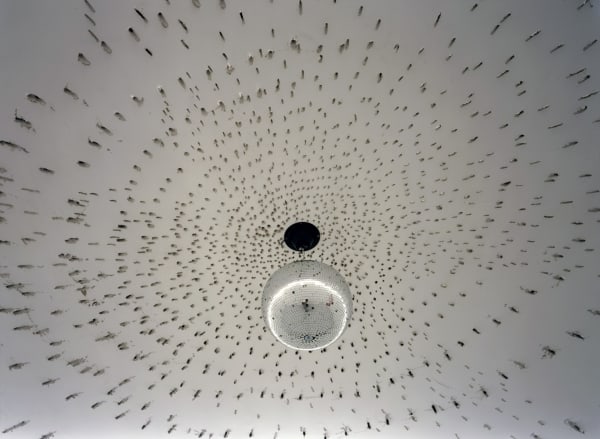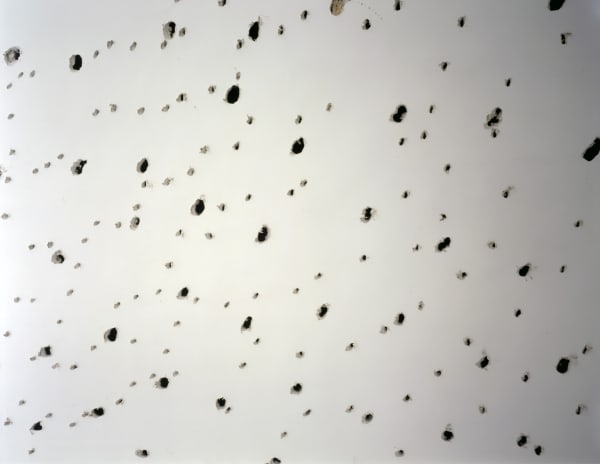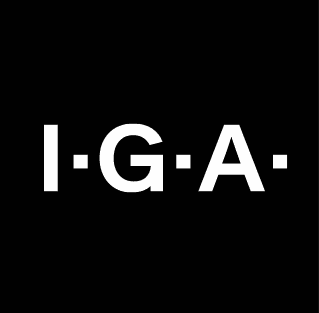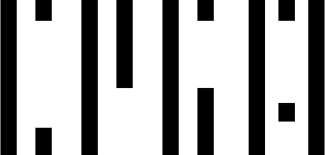Galerie Peter Kilchmann is pleased to announce the first solo exhibition by the Argentinean artist Jorge Macchi in Switzerland. Entitled Still Song, the exhibition comprises a room-installation of the same name, and new work on paper (drawings and silkscreens).
In kilchmann plus there is a new room especially constructed for the installation Still Song. When entering this room the visitor automatically sees the stagnant disco ball, which is hanging from the ceiling. A white strip of light is running around the upper edge of the room and serves as the only indirect source of light. Instead of the reflections of the disco ballʼs mirror panels there are differently sized holes irregularly covering the walls and the floor. It seems as if the light has aggressively burned itself into the walls and the ground. At this moment the recipient can either challenge himself by trying to figure out the reason for the sudden standstill or find out the original source of light. Beyond other things, the artistʼs work mainly focuses on the imagination of the visitor, the investigation of the standstill as a phenomenon as well as the play with dynamism and statics.
In the main room of the gallery, there are shown a series of smaller, pictogram-like watercolour drawings, presenting subjects such as heads, tools, music instruments and landscapes at night. These subjects are repeatedly dealt with by the artist throughout his Oeuvre. However, Macchi does not present these subjects in a naturalistic way, but much more connects them with each other. The thereby changed pictures compose the basis for a strange and sometimes humourously seeming picture catalogue. One example would be a head in profile with two saws sticking out, a tree made of hammers or a balloon with a moon and a torch. Moreover, 21 drawings are presented, entitled Moscas muertas (dead flies), which are placed on the wall as if they simulated the flight of a fly.
Furthermore we show silkscreen work consisting of ten pieces, entitled Doppelgänger (double). Every sheet shows a figure made out of text elements. Formally viewed at, the figures remind one of pictures from the Rohrschacht-Test. In these selfreflecting shapes animals and human outlines can be recognized. It is remarkable that the left figures are connected with the right figures by one or two words, which appear in the left as well as in the right text. These words function as interfaces for the artist. The content=text is taken from the Argentinean yellow press newspaper called Crónica and precisely tells about criminal occurrences taken from the section "policiales" (Police or Crime). The choice criterion for these police reports are/form the correspondent words which the artist stresses graphically, as for example "macabro hallazgo" (macabre finding) or "bañado en sangre" (covered in blood). So firstly, Macchi rearranges and challenges the well known subject of the double and secondly, he poetically questions the press covering of human tragedies and crimes. Thus, the installation function likes a memento mori against forgetting and the personal destinies in the million town of Buenos Aires.
The conceptual work by Jorge Macchi generally consists of installations, (found) objects, watercolour drawings, paper works and videos. Due to his education as an art teacher as well as a pianist, he is especially interested in the interweaving of fine arts and music. Since the end of the Nineties Macchi has been well-known for his cut-out city maps and newspapers as well as his cartographic investigations of Buenos Aires. Moreover, a re-occurring element of his work is the indicating of microstructures and macrostructures like city maps and linguistic sign systems. In his work he also repeatedly deals with the interplay of absence and presence (for example, of music and information).
 Jorge MacchiStill song, 2005Installation (dimension variable)600 x 800 x 300 cm (236.2 x 315.0 x 118.1 in.)Ed. 2/3 + 1 AP
Jorge MacchiStill song, 2005Installation (dimension variable)600 x 800 x 300 cm (236.2 x 315.0 x 118.1 in.)Ed. 2/3 + 1 AP Jorge MacchiMoscas muertas, 2002Gouache on paper, series of 21 drawings35.5 x 24.4 cm (14.0 x 9.6 in.), framed
Jorge MacchiMoscas muertas, 2002Gouache on paper, series of 21 drawings35.5 x 24.4 cm (14.0 x 9.6 in.), framed Jorge MacchiBlind Date, 2005Wall installation, nails, hammers, cord500 x 250 cm (196.9 x 98.4 in.)Unique
Jorge MacchiBlind Date, 2005Wall installation, nails, hammers, cord500 x 250 cm (196.9 x 98.4 in.)Unique








